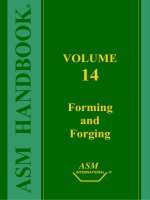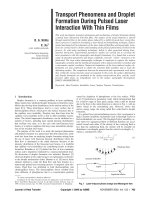strong and weak form
Bạn đang xem bản rút gọn của tài liệu. Xem và tải ngay bản đầy đủ của tài liệu tại đây (90.52 KB, 3 trang )
<span class='text_page_counter'>(1)</span><div class='page_container' data-page=1>
<b>Strong & Weak Forms</b>
In connected speech, many of the ‘small’ words we use very frequently tend to take on a
different ‘shape’ from the one listed in the dictionary. All of these words belong to the
category of function words, i.e. they are words that have little semantic content of their
own, but tend to have more grammatical or referential function in relating content words
or higher syntactic units to one another. Function words are essentially closed class
words, such as pronouns, prepositions, conjunctions, auxiliaries, etc. Below, you’ll find a
table listing these words, together with their strong or dictionary form, as well as their
potential weak forms. The following tables are based on Roach, 2000, with slight
modifications/additions.
In general, weak forms do tend not to occur in sentence-final position or in
contrastive/emphatic use.
<b>Determiners/Quantifiers</b>
<b>orthography</b> <b>strong form(s)</b> <b>weak form(s)</b>
the ði: ðɪ, ðə
a/an eɪ, an ə, ən
some sʌm səm, sm̩
<b>Pronouns</b>
<b>orthography</b> <b>strong form(s)</b> <b>weak form(s)</b>
his hɪz ɪz
him hɪm ɪm
her hɜ: ə
you ju: jʊ, jə
your jo: jə
she ʃi: ʃɪ
he hi: ɪ
we wi: wɪ
them ðɛm ðəm, əm
us ʌs əs, s
</div>
<span class='text_page_counter'>(2)</span><div class='page_container' data-page=2>
<b>orthography</b> <b>strong form(s)</b> <b>weak form(s)</b>
than ðan ðən
at at ət
for fo: fə
from fɹɒm fɹəm, fəm, fm̩
of ɒv əv, v
to tu: tə, tʊ
as az əz, z
there ðɛə ðə
<b>Conjunctions</b>
<b>orthography</b> <b>strong form(s)</b> <b>weak form(s)</b>
and and ənd, ən, n̩d, n̩
but bʌt bət
that ðat ðət
<b>Auxiliaries</b>
<b>orthography</b> <b>strong form(s)</b> <b>weak form(s)</b>
can kan kən, kn̩
could kʊd kəd
have hav əv, v
has haz əz, z
had had əd, d
will wɪl l
shall ʃal ʃəl, ʃl, l
should ʃʊd ʃəd
must mʌst məs, məst
do du: də, d
does dʌz dəz, z
am am əm, m̩
are ɑ: ə
</div>
<span class='text_page_counter'>(3)</span><div class='page_container' data-page=3>
were wɜ: wə
<b>Sources & Further Reading:</b>
Roach, P. 3<sub>2000. </sub><i><sub>English Phonetics and Phonology: a Practical Course</sub></i><sub>. Cambridge: </sub>
</div>
<!--links-->









